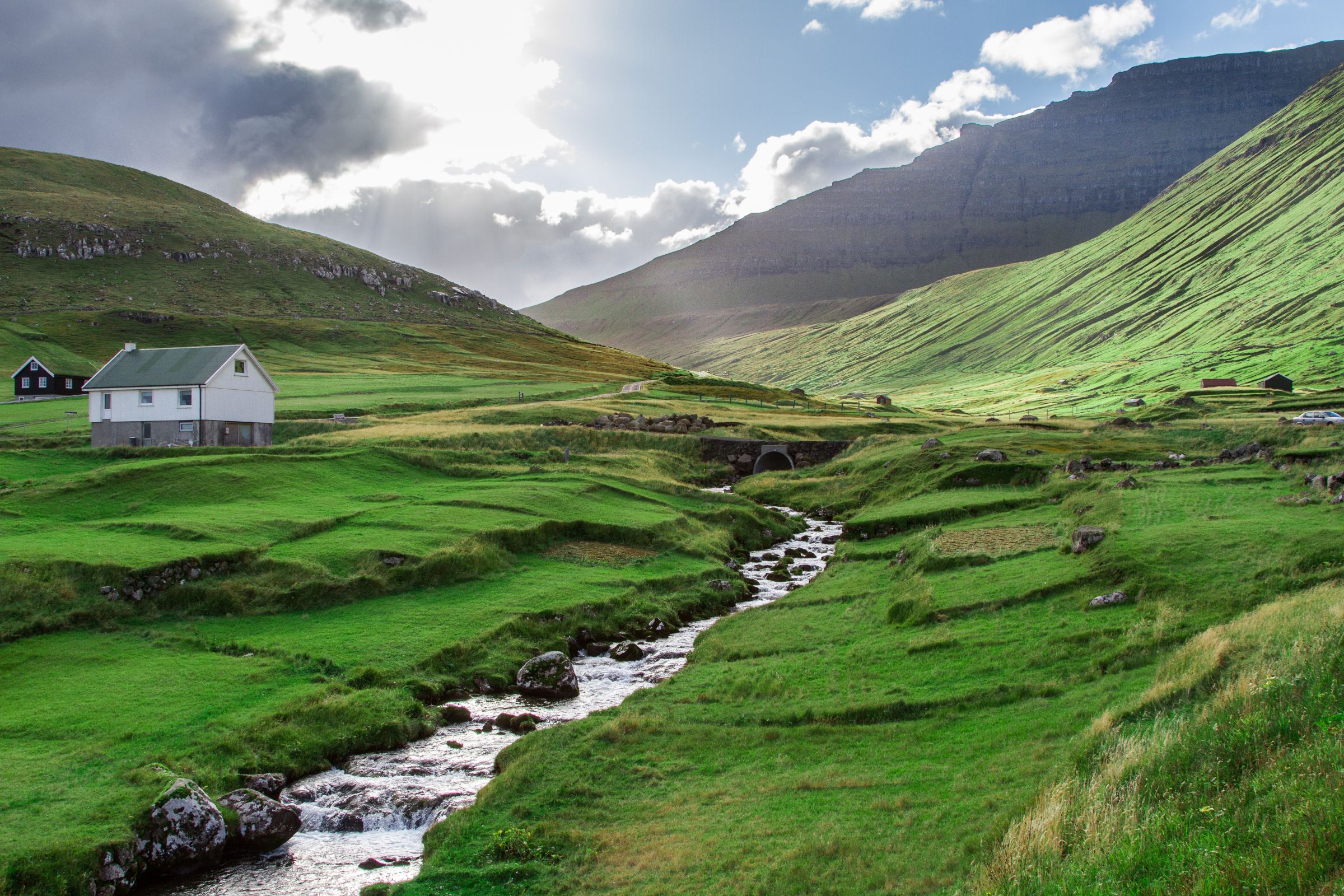The Faroe Islands Travel Guide
Expert Insights from a Luxury Travel Designer
Ker & Downey World Travel designer Catherine Brown traveled to the Faroe Islands, an emerging North Atlantic destination in October. The remote archipelago of 750 islands between Iceland and Norway offers dramatic fjords, world-class dining, and authentic cultural experiences—but also presents unique challenges that require expert planning.
After experiencing flight cancellations, weather extremes, and Michelin-level dining in one of Earth's most remote locations, Catherine returned with clear recommendations for how to visit the Faroe Islands successfully.

Intro to the Faroe Islands
Tucked away in the North Atlantic between Iceland and Norway, the Faroe Islands remain one of the world’s most remote and untouched destinations. This small archipelago of 750 islands, 18 of them main islands, feels like a place lost in time. The landscape is a dramatic mix of towering fjords, rolling green hills, and waterfalls that seem to appear every few minutes. Traveling through the islands means crossing high mountain passes and descending into tiny fishing villages of just a few dozen people, each one as authentic as the last.
As such, the sense of isolation here can feel almost otherworldly. Catherine called it “unnerving” to be surrounded by nothing but sea and sky in the middle of the North Atlantic. But for many, that remoteness is part of the magic. And for photographers and explorers alike, the Faroe Islands offer a rare gift of raw beauty and quiet wonder.
How to Get to the Faroe Islands: Flight Routes Compared
Two main routes can reach Tórshavn, the main gateway into the Faroe Islands. While some travelers may opt to fly via Iceland, Ker & Downey does not recommend this route. The Reykjavik–Tórshavn leg relies on small prop planes that are frequently canceled due to weather. Furthermore, Icelandair has no staff or airport presence in the Faroe Islands to assist with rebooking.
We recommend flying via mainland Europe through cities like Copenhagen, Oslo, London, or Barcelona with Atlantic Airways. These flights use larger, more reliable aircraft that experience far fewer cancellations. Although Atlantic Airways flights are less frequent and may cost slightly more, Catherine emphasizes they are worth it for the safety, reliability, and peace of mind they offer.
When to Visit the Faroe Islands
Travel in the Summer Months
"It's definitely best to visit in June, July, August, or September," Catherine states firmly. "However, the weather is always unpredictable in this region. It can change on a dime."
What October Weather Actually Looks Like
Catherine traveled in late October and experienced why the shoulder season proves a tougher time to travel.
"On my last day, every flight was grounded," she reflects. "I looked out the window and saw a break in the clouds, so I headed to check out of my hotel thinking that I could make it to the airport. A few minutes later, however, I walked out the front door and it was downpouring and the wind had picked up”
Catherine’s recommendation: Stick to the summer months when the weather is most stable. You’ll experience fewer flight cancellations, longer daylight for activities, and plenty of puffins.
Where to Stay in the Faroe Islands
#1 Choice: Nólsoyarstova
Located in the middle of downtown on the harbor, Nólsoyarstova is a boutique hotel run by a husband and wife who have renovated three apartments within a historic building right on the waterfront.
Why it's #1:
- Only 3 apartments = intimate, exclusive
- Owner-operated with personalized service
- Prime waterfront location in Tórshavn
- Walking distance to all top restaurants
- Historic building with character
- Breakfast provisions included
- Optional private chef service
"It's fancy but comfortable," Catherine describes. "That alone is just an experience—to be in that property and dine at the restaurants."
#2 Choice: Havgrím Seaside Hotel
Located on the water, the hotel is an old naval house with tons of character and authentic Faroese atmosphere. The rooms are small, but charming, and the Ambassador Suite offers panoramic views.
Catherine also recommends going further afield and staying at a villa, away from the mainstream hotels.

Private Faroe Islands Tour
Discover the magic of the North Atlantic on a journey through dramatic landscapes, vibrant culture, and world-class cuisine. Ker & Downey World Travel's singular Faroe Islands itinerary blends adventure, intimate local encounters, and exclusive experiences.
Explore the ItineraryWhere to Eat on the Faroe Islands
The Dining Scene Surprise
Perhaps the biggest surprise of the Faroe Islands is its cuisine. Indeed, Tórshavn punches far above its weight with Michelin-recognized restaurants in the middle of the North Atlantic.
"I find it so interesting that the Faroe islands are so remote and yet they have this level of dining," Catherine marvels. "What's more, because the top restaurants want everything to be super local, they are using what they’re foraging and finding on a daily basis."
Catherine's Restaurant Recommendation
Catherine’s top restaurant choice in the Faroe Islands is ROKS. They offer a 12-course fermented tasing menu with a Mexican twist on Faroese ingredients. The restaurant is set in a home, not a traditional restaurant. It’s Michelin-recognized, and easily her most creative and memorable dining experience.
"I loved, loved, loved ROKS," she exclaims. "It was all fermented with a Mexican twist. It was just such a special experience, and I couldn’t believe I was there."
Best Faroe Islands Activities
#1 Experience: Home Cooking with Local Families
After fishing with a guide in a fjord village, Catherine and her guide cooked the catch at his sister's house.
"We brought the fish to his sister's house to cook and have stew and sit around and talk, learn about life for them and swap stories," she describes. "I always am a little leery of that because sometimes it doesn't feel authentic. But this was genuinely special. Nobody was dressed up. They were in their socks and their three teenagers were coming and going naturally. It offered real conversation, not performative tourism."
Catherine emphatically states this was the favorite part of her trip.
Other Available Activities
- Fishing in the Fjords
- Puffin Viewing, best during the summer months when they are nesting
- Private boat tours to nearby islands
- Photography tours across dramatic landscapes
- E-bikes for village exploration
- Village-to-village hiking
- Helicopter touring (weather permitting)
- Cold plunge and sauna in wilderness settings
- Aerial photography of remote puffin colonies
Frequently Asked Questions About Faroe Islands Travel
Q: How do I get to the Faroe Islands?
A: The best way to get there is on Atlantic Airways via Copenhagen, Oslo, London, or Barcelona.
Q: When is the best time to visit the Faroe Islands?
A: June through September. Catherine traveled in October and experienced extreme weather that grounded all flights. Summer offers most stable conditions, though flexibility remains essential.
Q: Where should I stay in the Faroe Islands?
A: Nólsoyarstova in Torshavn—a husband-wife operated property with only 3 apartments in a historic waterfront building. Stay 3 nights here, then consider remote villas for extended trips.
Q: How does the Faroe Islands compare to Iceland?
A: Smaller scale with fewer dramatic natural phenomena. There aren’t lava caves or ice caves like there are in Iceland. But what the Faroe Islands lacks in activity variety, it makes up for with authentic villages, world-class dining, cultural depth, and genuine remoteness.
Q: What’s the best way to see the Faroe Islands?
The islands combine really well with mainland Europe. Copenhagen, Norway, and Scotland would work for a really fun itinerary with lots of variety.
Q: What's the #1 activity to book?
A: Home cooking experience with local families. Unlike touristy versions elsewhere, this experience is genuinely authentic.
Q: How should I handle the whale hunting topic?
A: Approach with cultural sensitivity and openness to understanding different perspectives. Note that it is part of the local culture and that the local guides welcome the opportunity to speak openly about it.
Catherine's Final Verdict on the Faroe Islands
"I get excited about a destination like this where it's so expansive and not many people think of it," Catherine reflects.
For travelers who are comfortable with flexibility, value authentic cultural experiences, enjoy world-class dining in unexpected places, and seek destinations before mass tourism, the Faroe Islands is an ideal destination.
"There's so much there that is well worth the trip," Catherine concludes. "It's very different and kind of unnerving to be so remote in the middle of the North Atlantic—that's a cool feeling on its own."
Ready to Plan Your Faroe Islands Adventure?
Traveling to the Faroe Islands requires expert planning to navigate weather unpredictability, flight logistics, and activity coordination. Nearly every activity—from boat excursions to village visits—depends on local weather conditions. That’s why Ker & Downey World Travel partners with expert on-the-ground teams who manage every detail in real time. Rather than following a rigid, pre-set itinerary, our local team adjusts each day’s plans to make the most of the weather and ensure you never miss an experience.
When you book through Ker & Downey World Travel, you gain access to that seamless coordination—guides who can instantly swap a fishing trip for a scenic drive or rearrange activities on the fly. We take care of the logistics so you can relax and enjoy an effortless, fully optimized journey through one of the world’s most remote and breathtaking destinations.
The Faroe Islands await—remote, dramatic, and authentically Nordic.

Talk to A Travel Designer
Get advice and suggestions to make this your perfect trip.
Or give us a call at 800.423.4236.
Inquire NowSee What We Are Up To
Subscribe to our Weekly Newsletter for Travel Tips and Insider Guides for Planning your Next Journey!
